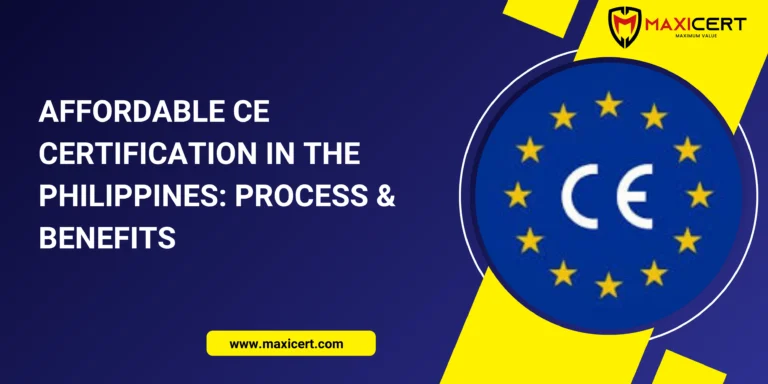Affordable CE Certification in the Philippines: Process & Benefits

Introduction
Believing CE certification to be too costly? You’re not the only one. Most companies in the Philippines—particularly startups and small-scale manufacturers—tend to think that CE certification is unaffordable based on high expenditures. But this is not always the case. With careful planning, a good consultant, and a cost-effective method, CE certification proves to be very affordable.
This blog describes how to become CE certified at a reduced price, what is involved, and the advantages to Philippine exporters who want to penetrate the European market.
What Is CE Certification?
CE certification is a product marking that shows your product meets the required European Union (EU) standards for safety, health, and environmental protection. This mark is mandatory for many products if you want to sell them in the EU. These include a wide range of items like electronics, machinery, toys, medical devices, and more.
The term “CE” stands for “Conformité Européenne,” which means “European Conformity.” It tells regulators, importers, and customers that your product has passed the necessary checks and follows EU laws.
Once your product is CE marked, you are allowed to sell it freely across all EU and EEA member countries—more than 30 in total. Just as important, it gives buyers and government authorities confidence that your product meets important technical and legal requirements, helping you avoid market rejections, fines, or recalls.
Request A Free Quote
Why CE Certification Is Worth It
CE certification is not just a regulatory requirement—it’s a door to global credibility. Here’s why Philippine firms should take it seriously:
- Market Access: CE-marked products can be sold freely in the EU without further local regulatory checks.
- Consumer Confidence: European consumers tend to prefer or demand CE-marked products.
- Legal Compliance: It’s obligatory for most product groups.
- Competitive Advantage: It indicates your brand is concerned about quality and safety.
Discover our ISO certification services in the Philippines to complement your CE conformity.
Busting the Myth – CE Certification at a Reasonable Cost
Cost Drivers Behind CE Certification
The overall cost of CE certification is based on:
- Product classification (low-risk vs high-risk)
- Testing requirements
- Documentation requirements
- Involvement of a Notified Body (if necessary)
Numerous companies believe they have to pay thousands of dollars upfront. In fact, low-risk products don’t require a Notified Body in some cases, so self-declaration and CE marking are cheaper.
How to Minimize Certification Costs
- Do a Compliance Gap Analysis: Know where you are now.
- Use Document Templates: Save money and time on technical documents.
- Limit Redundant Testing: Re-use test data where available.
- Bundle Services: Package CE marking with ISO 9001 or ISO 13485 implementation.
- Choose a Cost-Effective Consultant: Experts like Maxicert understand the financial constraints of Philippine businesses and offer tailored, affordable solutions.
Step-by-Step Guide to CE Certification in the Philippines
Step 1 – Determine Relevant EU Directive & Product Classification
Begin by determining which EU legislation applies. For instance:
- Medical Devices: EU MDR 2017/745
- Machinery: Machinery Directive 2006/42/EC
- Electronics: Low Voltage Directive 2014/35/EU
Then categorize your product within one of the risk categories. Less complex products can take self-declaration; more complex or high-risk products need a Notified Body.
Step 2 – Create Technical Documentation
You will need to create a technical file containing:
- Product description
- Design drawings
- Risk assessment
- Test results
- User manuals
Tip: Use pre-formatted templates to save time and expense.
Step 3 – Conduct Conformity Assessment
If your product is in a high-risk category, use an EU Commission-approved Notified Body. Otherwise, self-declaration of conformity can be done. Utilize the EU CE compliance portal to search for accredited bodies.
Step 4 – Issue Declaration of Conformity & Add CE Mark
Lastly, sign a Declaration of Conformity and add the CE mark prominently to your product. Ensure you also comply with the EU regulations on mark placement and size.
CE Certification vs Other Certifications – Which One Is Less Expensive?
| Certification | Region | Cost & Complexity | Notes |
|---|---|---|---|
| CE Certification | European Union (EU) | Generally more affordable, especially for low-risk products | Ideal for businesses targeting the European market |
| FDA Approval | United States | Often costly and time-consuming | Requires detailed clinical data and longer timelines |
| TGA Certification | Australia | Strict and often expensive, especially for medical devices | Similar to FDA, but with different documentation and assessment pathways |
| ISO Certifications | Global | Usually less expensive and process-focused | Often complements CE marking but doesn’t replace product compliance |
CE certification is often the more budget-friendly option for manufacturers planning to sell in Europe. While it still requires technical compliance, the overall cost and time investment can be lower compared to FDA or TGA approvals, especially for low to medium-risk products.
Actual Benefits of Low-Cost CE Certification
- Market growth: Sell freely throughout the EU and EEA
- Rapid regulatory approvals overseas
- Enhanced product credibility with buyers and investors
- Lessened legal risk for non-compliance
Done correctly, CE certification provides substantial ROI.
CE Certification for Small Businesses & Startups in the Philippines
Startups tend to be concerned with cost. This is how they can thrive:
- Utilize free EU guide documents
- Certificate planning into product development from the start
- Consult local consultants with knowledge of low-cost options
- Cooperate with test laboratories providing SME discounts
Even small enterprises may fulfill CE requirements without straining their budget.
Common Expensive Mistakes and How to Get Around Them
- Incorrect product classification
- Incomplete documentation
- Excessive use of Notified Bodies
- Excessive payment for testing
- Omitting internal audits or QMS alignment
- Incorrect product classification
Avoiding these errors can cut overall certification expense by 30% or more.
How Maxicert Assists You to Avail CE Certification at a Lower Cost
Maxicert offers cost-friendly CE consulting specific to Philippine enterprises:
- Tailored packages for startups, exporters, and manufacturers
- Domestic support for quicker communication and advice
- Services like ISO 13485 and QMS conformity
- Documentation templates and technical file audit
We expedite the process quicker, easier, and within budget.
Conclusion
It’s a misconception that only big businesses can pay for CE marking. With the right strategy and local knowledge, Philippine SMEs and even individual inventors can comply with EU requirements. CE certification is your key to the European market—and it’s closer than you imagine.
Interested in getting CE certified without breaking the bank?
Maxicert provides CE consulting expertise at a budget that works best for Philippine businesses—particularly SMEs and exporters.
Reach out to us today and begin your CE certification process the smart, cost-effective way.

Get In Touch

Get In Touch

Get In Touch
Need A Free Estimate?
Get a free consultation and Checklist to get certified for ISO , HALAL, CE Mark Certification.
FAQ
What is the purpose of CE certification?
CE certification ensures that a product meets European Union standards for safety, health, and environmental protection, allowing it to be sold legally in the EU market.
Do all products need CE certification to enter Europe?
Certain product categories—such as electronics, machinery, medical devices, and toys—require CE marking under EU directives.
Can a small business in the Philippines afford CE certification?
Yes. With the right guidance and low-risk products, many small businesses can complete CE certification through self-declaration and avoid unnecessary expenses.
How long does it take to get CE certified?
The timeline depends on the product type and risk level. For low-risk products, it may take a few weeks. Higher-risk products requiring a Notified Body may take several months.
Is CE certification permanent?
No. CE certification must be maintained. If your product changes or if EU regulations are updated, you may need to reassess and update your conformity documentation.





